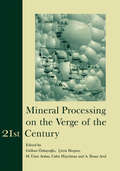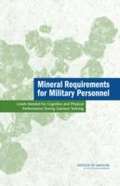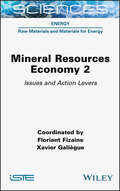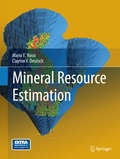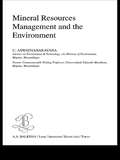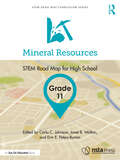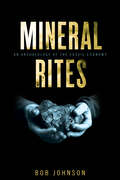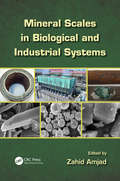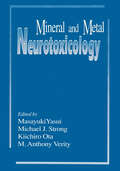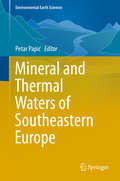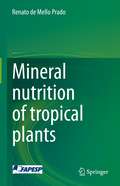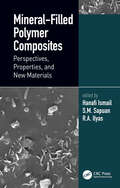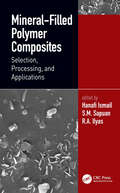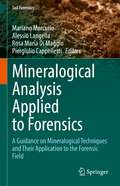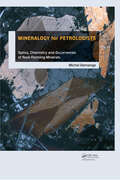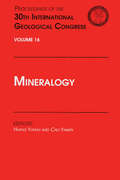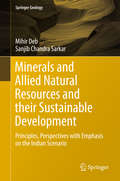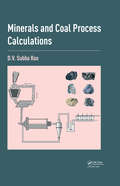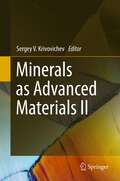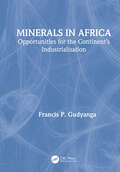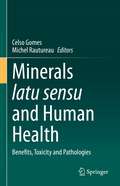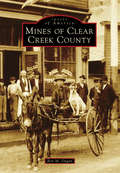- Table View
- List View
Mineral Processing on the Verge of the 21st Century: Proceedings of the 8th International Mineral Processing Symposium, Antalya, Turkey, 16-18 October 2000
by Gülhan Özbayoğlu Çetin Hoşten M. Ümit Atalay Cahit Hiçyılmaz A. İhsan ArolThis collection of papers covers many topics in the area of mineral processing, such as: physical enrichment processing; fine particle processing; flotation fundamentals and technology; industrial minerals processing; and waste treatment and utilization.
Mineral Rents and the Financing of Social Policy
by Katja HujoAn exploration of the implications of mineral-led wealth and the opportunities that this creates for economic and social development. The book includes theoretical and policy analyses as well as micro level country case studies, including Norway, Chile, Indonesia, Nigeria and Botswana.
Mineral Requirements for Military Personnel: Levels Needed for Cognitive and Physical Performance During Garrison Training
by Institute of Medicine of the National AcademiesThe National Academies Press (NAP)--publisher for the National Academies--publishes more than 200 books a year offering the most authoritative views, definitive information, and groundbreaking recommendations on a wide range of topics in science, engineering, and health. Our books are unique in that they are authored by the nation's leading experts in every scientific field.
Mineral Resource Economy 2: Issues and Action Levers
by Florian Fizaine Xavier GaliègueThe challenges associated with the environmental impact of renewable energies are formidable and multiple. The exploitation of diffuse forms of energy will require us to reshape our lifestyles and infrastructures. Reducing their environmental impact is imperative and requires the mobilization of all available levers of action.Beyond the analysis of these challenges, this book presents an overview of the levers of action that should allow us to meet them, by crossing the fields of the human sciences, geosciences and engineering. The levers of action examined are both technical (through the substitution or use of low technology) and economic and social (through the development of recycling or decoupling). The book also addresses the question of their effectiveness and their overall impact.
Mineral Resource Estimation
by Clayton V. Deutsch Mario E. RossiMineral resource estimation has changed considerably in the past 25 years: geostatistical techniques have become commonplace and continue to evolve; computational horsepower has revolutionized all facets of numerical modeling; mining and processing operations are often larger; and uncertainty quantification is becoming standard practice. Recent books focus on historical methods or details of geostatistical theory. So there is a growing need to collect and synthesize the practice of modern mineral resource estimation into a book for undergraduate students, beginning graduate students, and young geologists and engineers. It is especially fruitful that this book is written by authors with years of relevant experience performing mineral resource estimation and with years of relevant teaching experience. This comprehensive textbook and reference fills this need.
Mineral Resources Management and the Environment
by U. AswathanarayanaThrough an exploration of the links between geologic setting, mining and process technologies, economics, environment and stakeholder communities, this text addresses ways in which the mineral industry can be made safe, efficient and ecologically sustainable, focusing in particular upon the following key themes: a review of the current status of t
Mineral Resources, Economics and the Environment
by Kesler, Stephen E. and Simon, Adam C. Stephen E. Kesler Adam C. SimonWritten for students and professionals, this revised textbook surveys the mineral industry from geological, environmental and economic perspectives. Thoroughly updated, the text includes a new chapter on technology industry metals as well as separate chapters on mineral economics and environmental geochemistry. Carefully designed figures simplify difficult concepts and show the location of important deposits and trade patterns, emphasising the true global nature of mineral resources. Featuring boxes highlighting special interest topics, the text equips students with the skills they need to contribute to the energy and mineral questions currently facing society, including issues regarding oil pipelines, nuclear power plants, water availability and new mining locations. Technical terms are highlighted when first used, and references are included to allow students to delve more deeply into areas of interest. Multiple choice and short answer questions are provided for instructors online at www. cambridge. org/kesler to complete the teaching package.
Mineral Resources, Grade 11: STEM Road Map for High School (STEM Road Map Curriculum Series)
by Carla C. Johnson Erin E. Peters-Burton Janet B. WaltonWhat if you could challenge your eleventh graders to come up with a design solution for developing, managing, and utilizing mineral resources? With this volume in the STEM Road Map Curriculum Series, you can! Mineral Resources outlines a journey that will steer your students toward authentic problem solving while grounding them in integrated STEM disciplines. Like the other volumes in the series, this book is designed to meet the growing need to infuse real-world learning into K–12 classrooms. This interdisciplinary, three-lesson module uses project- and problem-based learning to help students develop an in-depth understanding of mineral resources by researching the utility and impact of particular mineral resources on society. Working in teams, students will locate quantitative and qualitative data on mineral resources and discern the reliability of the information, then use their data to write an opinion article and develop a website to convince readers of the effectiveness of a particular design solution for developing, managing, and utilizing mineral resources. To support this goal, students will do the following: Explain how mineral resources are located and used in various ways in society. Explain why mineral resources are important to society. Critically evaluate quantitative and qualitative data about mineral resources. Write an opinion article demonstrating their knowledge about competing design solutions for extracting mineral resources. The STEM Road Map Curriculum Series is anchored in the Next Generation Science Standards, the Common Core State Standards, and the Framework for 21st Century Learning. In-depth and flexible, Mineral Resources can be used as a whole unit or in part to meet the needs of districts, schools, and teachers who are charting a course toward an integrated STEM approach.
Mineral Rites: An Archaeology of the Fossil Economy (Energy Humanities)
by Bob JohnsonAn archaeology of Western energy culture that demystifies the role that fossil fuels play in the day-to-day rituals of modern life.Spanning the past two hundred years, this book offers an alternative history of modernity that restores to fossil fuels their central role in the growth of capitalism and modernity itself, including the emotional attachments and real injuries that they generate and command. Everything about us—our bodies, minds, sense of self, nature, reason, and faith—has been conditioned by a global infrastructure of carbon flows that saturates our habits, thoughts, and practices. And it is that deep energy infrastructure that provides material for the imagination and senses and even shapes our expectations about what it means to be fully human in the twenty-first century. In Mineral Rites, Bob Johnson illustrates that fossil fuels are embodied today not only in the morning commute and in home HVAC systems but in the everyday textures, rituals, architecture, and artifacts of modern life. In a series of illuminating essays touching on such disparate topics as hot yoga, electric robots, automobility, the RMS Titanic, reality TV, and the modern novel, Johnson takes the discussion of fossil fuels and their role in climate change far beyond the traditional domains of policy and economics into the deepest layers of the body, ideology, and psyche. An audacious revision to the history of modernity, Mineral Rites shows how fossil fuels operate at the level of infrapolitics and how they permeate life as second nature.
Mineral Scales in Biological and Industrial Systems
by Zahid AmjadSoluble and insoluble impurities present in water used for domestic and industrial applications can lead to the deposition of unwanted materials on equipment surfaces. Impurities such as dissolved minerals, natural organic compounds, and suspended particles can impact various processes and systems including boiling and cooling processes, desalinati
Mineral and Metal Neurotoxicology
by Masayuki Yasui M. Anthony VerityTrace minerals and metals such as zinc, copper, and magnesium are accepted as a "natural" part of the human system. Interactions of some elements and/or disturbances in trace-metal or mineral homeostasis can, however, be toxic to the central nervous system (CNS). Mineral and Metal Neurotoxicology describes a wide range of basic and clinical issues
Mineral and Thermal Waters of Southeastern Europe
by Petar PapićThis book brings together the latest findings on mineral and thermal waters from countries in Southeastern (SE) Europe (Croatia, Bosnia and Herzegovina, Serbia, Montenegro, Macedonia, Albania, Romania and Bulgaria). Each chapter is dedicated to the most recent geochemical and hydrogeological investigations for a specific country in SE Europe, helping readers to understand the origins and applications of mineral and thermal waters - aspects which are of great importance for the economic development of this region, as these waters are renewable resources, and have been gaining in popularity over the last few decades. Thanks to the region's favorable geological conditions, it is home to more than 6,000 sources of mineral and thermal waters, characterized by different physical properties and chemical compositions.
Mineral nutrition of tropical plants
by Renato de Mello PradoThis textbook aims to describe the role of minerals in plant life cycle; how these nutrients are absorbed, distributed, stored; what functions each mineral plays and the disorders that their excess or absence may cause. From an agronomic perspective, such knowledge is key to boost crop production and improve its quality, and it also helps understand how to better manage fertilizers and prevent environmental issues. The book has focus on tropical agriculture and its specific demands, providing examples of major crops (such as sugarcane, soybeans, coffee etc), silviculture and pasture species.
Mineral-Filled Polymer Composites: Perspectives, Properties, and New Materials
by S. M. Sapuan R. A. Ilyas Hanafi IsmailMineral-filled polymer composites are widely used in industries across the globe, and applications are continuously increasing in sectors such as shipping, manufacturing and renewable energy. One of two volumes comprising the Mineral-Filled Polymer Composites Handbook, this volume provides an overview of the latest research and future directions of advanced mineral fiber-reinforced polymer composites, focused specifically on materials properties. It covers fundamentals, recent progress and new materials involved in mineral-filled polymer composites and includes a wide-ranging list of chapters authored by an international team of experts. This book: Examines the properties of a wide range of materials, from macro- to nano-sized Highlights resources for bio-based minerals production and compares bio-based minerals with commercial mineral fillers Covers novel synthesis methods Discusses effects of aging on properties Describes using halloysite and montmorillonite to improve composite properties and the potential of using mineral fillers to enhance the properties of biopolymer and synthetic polymers This book serves as an excellent reference guide for researchers, advanced students, academics and industry professionals interested in the synthesis of mineral-filled polymer and biopolymer composites, as well as those pursuing research in the broad fields of composite materials, polymers, organic/inorganic hybrid materials and nano-assembly.
Mineral-Filled Polymer Composites: Selection, Processing, and Applications
by S. M. Sapuan R. A. Ilyas Hanafi IsmailMineral-filled polymer composites are increasingly used for various applications, including automotive, construction, biomedical, maritime, sport and ballistic, due to the advantages of low cost, light weight, excellent rigidity and high mechanical strength. One of two volumes comprising the Mineral-Filled Polymer Composites Handbook, this volume provides an overview of the latest research, trends, applications and future directions of advanced mineral fiber-reinforced polymer composites. It focuses specifically on material selection, processing and applications. This book: Emphasizes the principles governing the behavior of mineral-filled composite materials in the field of engineering and their applications Covers systematic material selection tools such as analytical hierarchy process (AHP), analytical network process (ANP), and technique of ranking preferences by similarity of the ideal solution (TOPSIS) Reviews the use of these materials for various engineering applications Features chapters looking at fabrication techniques and frictional properties Details current research in polymer nanocomposites and particulate polymer composites This book serves as an excellent reference guide for researchers, advanced students, academics and industry professionals interested in the synthesis of mineral-filled polymer and biopolymer composites, as well as those pursuing research in the broad fields of composite materials, polymers, organic/inorganic hybrid materials and nano-assembly.
Mineralogical Analysis Applied to Forensics: A Guidance on Mineralogical Techniques and Their Application to the Forensic Field (Soil Forensics)
by Rosa Maria Di Maggio Mariano Mercurio Alessio Langella Piergiulio CappellettiThis book illustrates the main modern mineralogical analytical procedures that can be applied for forensic purposes on various typologies of materials and substances and has both theoretical and practical approach. Moreover, it focuses on all those challenges that can arise with forensic analysis, such as the choice of the most proper mineralogical techniques as a function of the material and its quantity, destructive and non-destructive analyses, sampling procedures, mineralogical analysis of micro-traces, correct preparation of the samples, correct calibration and analytical conditions of the laboratory instrumentation. Numerous case studies on criminal offenses against persons, environment and cultural heritage are illustrated.
Mineralogy for Petrologists: Optics, Chemistry and Occurrences of Rock-Forming Minerals
by Michel Andre DemangeThis book provides a categorized and visualized overview and presents microscopic observations, systematic mineralogy, chemistry, geology, stability, paragenesis, occurrence and use in petrology of 137 minerals. Structural formula calculations are included in the appendix. Consists of a set of book and downloadable resources for students and practically-oriented researchers and professionals in geology, geological, mining, and mineral resources engineering who need a reference of mineralogy, applied to petrology.The downloadable resources contain 384 color plates with mineral microscopic visuals under various circumstances.
Mineralogy: Proceedings of the 30th International Geological Congress, Volume 16
by Huang Yunhui Cao YawenThis book is a collection of papers presented in the 30th International Geological Congress, held in Beijing, on mineralogy. The papers deal with topics on fine structures and crystallographic orientations in biogenic magnetite and thermodynamic properties of minerals.
Minerals and Allied Natural Resources and their Sustainable Development
by Sanjib Chandra Sarkar Mihir DebNonrenewable natural resources - metallic and non-metallic minerals, industrial rocks and energy resources (both organic and inorganic), have been treated in a holistic manner in this book, including two important resources (soil and water), not commonly covered in most books on this topic. For the uninitiated reader, an introductory chapter looks into some basic definitions as well as nature and characteristics of mineral deposits followed by a chapter on the different crustal processes that produce the various ore deposits in the endogenous and exogenous environments. The strength of the book lies in its critical treatment of the genetic processes of the mineral deposits, their classification and the geodynamic context of metallogeny, and coverage of sustainable development of mineral deposits with special reference to various socio-economic as well as regulatory and environmental issues that face the Indian mining industry today. The text is punctuated with examples of Indian deposits, balanced with classical deposits around the world, to cater to the interests of Indian students and the international readership. This is a book for advanced undergraduate and post-graduate students of Geology, Environmental Sciences and Natural Resource Management.
Minerals and Coal Process Calculations
by D.V. Subba RaoThe aim of process calculations is to evaluate the performance of minerals and coal processing operations in terms of efficiency of the operation, grade of the final products and recovery of the required constituents. To meet these requirements, in-depth detailed calculations are illustrated in this book. This book is designed to cover all the process calculations. The method and/or steps in process calculations have been described by taking numerical examples. Process calculations illustrated in a simple and self explanatory manner based on two basic material balance equations will allow the reader to understand the contents thoroughly. Inclusion of elaborate process calculations in every chapter is the highlight of this book. This book is unique and devoted entirely to the process calculations with sufficient explanation of the nature of the calculations. This book will prove useful to all: from student to teacher, operator to engineer, researcher to designer, and process personnel to plant auditors concerned with minerals and coal processing.
Minerals as Advanced Materials II
by S V KrivovichevThis book is a collection of papers that are devoted to various aspects of interactions between mineralogy and material sciences. It will include reviews, perspective papers and original research papers on mineral nanostructures, biomineralization, micro- and nanoporous mineral phases as functional materials, physical and optical properties of minerals, etc. Many important materials that dominate modern technological development were known to mineralogists for hundreds of years, though their properties were not fully recognized. Mineralogy, on the other hand, needs new impacts for the further development in the line of modern scientific achievements such as bio- and nanotechnologies as well as by the understanding of a deep role that information plays in the formation of natural structures and definition of natural processes. It is the idea of this series of books to provide an arena for interdisciplinary discussion on minerals as advanced materials.
Minerals in Africa: Opportunities for the Continent’s Industrialisation
by Francis P. GudyangaAfrica’s dire need to industrialize is universally acknowledged and it is evident that the continent’s vast mineral resources can catalyze that industrialization. This requires the promotion of local beneficiation and value addition of minerals to yield materials on which modern Africa’s industry and society can rely. This book is, therefore, about transforming Africa’s comparative advantages in minerals into the continent’s competitive edge regarding materials. Mineral beneficiation and value addition form the basis and provide opportunities for mineral-driven Africa’s industrialization. The scope of the book is three-fold with inter-connected relationships: Information, Technical, and Policy oriented. It will be a useful reference material for mining undergraduate students on beneficiation and value addition of each of the minerals found in Africa. The book, while presenting a broad overview of beneficiation and value addition of Africa’s minerals, provides crucial starting material for postgraduate research students and R&D institutions who wish to delve into more advanced methods of extraction and utilization of mineral-derived materials that are in Africa for the purpose of industrialization of the continent.
Minerals latu sensu and Human Health: Benefits, Toxicity and Pathologies
by Michel Rautureau Celso GomesThis volume provides a comprehensive academic review of both positive and negative effects of minerals on human health and quality of life. The book adopts the concept of mineral latu sensu (mineral l.s.), which encompasses a broad spectrum of natural, inorganic, solid, and crystalline, of natural and inorganic chemical elements (metals and metalloids), of modified natural minerals, of biominerals, and of syntetic minerals, all products that branch across the disciplines of earth, soil, environmental, materials, nutrition, and health sciences. Using this broad framework, the authors are able to provide a multidisciplinary assessment on many types of minerals which can be essential, beneficial and hazardous to human health, covering applications in medical geology, medical hydrology or balneotherapy, pharmacology, chemistry, nutrition, and biophysics. The book performs historical analyses of the uses of minerals for therapeutic and cosmetic purposes to better understand current trends and developments in mineral research and human health. The book will be of interest to students, public health officials, environmental agencies and researchers from various disciplines, as well as scientific societies and organizations focusing on medical geology, health resort medicine (crenotherapy, hydrotherapy and climatotherapy), and on pharmaceutical, cosmetic and biomedical applications.
Mines and Miners of Cornwall and Devon: The Tin and Copper Industries
by Anthony BurtonThe eminent historian and author of The Rise of King Cotton uncovers the centuries-old story of tin mining in Southern England.Tin mining has existed in Cornwall and parts of Devon since before the Romans arrived in Britain. In this book, historian Anthony Burton explores the region’s tin mining industry from its earliest period through to the present day.A specialist in the history of technology, Burton examines the evolution of extraction methods from primitive pick and shovel operations to the later use of explosives, the rise of steam power, and beyond. Burton also looks at the changing politics and economics of the tin mining industry over the centuries.
Mines of Clear Creek County
by Ben M. DuganIn 1859, "Pikes Peak or bust!" spread across America and brought men and their families from all over to the Kansas goldfields seeking a new beginning. Thousands came to Clear Creek and Gilpin Counties and eventually settled all of Colorado. The mining communities of Idaho Springs, Georgetown, Empire, Silver Plume, Dumont, and Lawson all exist because of the pursuit of gold and silver. Gold was initially easy to get to, but in time, underground mineral development was necessary. New technologies and the Industrial Revolution made mining easier, but there was still work to be done to establish local fire departments, churches, schools, and governments.
